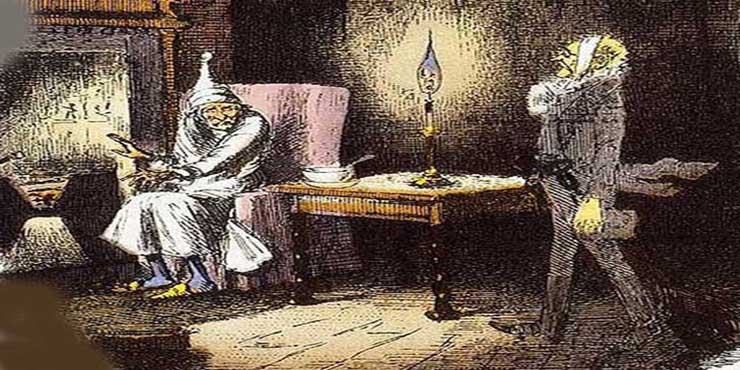
Ebenezer Scrooge's encounter with the ghosts of Christmas past, present and yet to come - not to mention with the spectre of his dead partner, Jacob Marley - is, probably, the second best known Christmas story ever told.
It has thrilled and chilled readers and audiences alike since December 1843, when Ebenezer Scrooge, Bob Cratchit and Tiny Tim, together with their Christmas message of redemption and goodwill, first found their way into the hearts and minds of the 19th century reading public.
Indeed, no sooner had the book appeared, than Dickens friend and fellow novelist, William Makepeace Thackeray, declared it "...a national benefit, and to every man or woman who reads it a personal kindness."
Amazingly, given that it is Dickens's best known and best loved story, it took him a mere six weeks to write.
Yet, the story itself is remarkable in so many ways.
Firstly, it impacted not just on the imaginations of its readers, but also on their emotions.
Secondly, it is probably the most performed of all Charles Dickens works and millions, if not billions of people have, over the years, been thrilled and chilled by its narrative in films, television productions, private readings and in stage adaptations.
Significantly, it is a story to be told rather than to be read and Dickens would, not doubt, be thrilled to know that it has become the most performed of all his works, with countless stage, film, radio and television adaptations.
Even the structure of the novella lends itself to performance as Dickens set the book out, not in chapters, but in musical staves.
Performances of it began almost immediately upon its publication, as many a Victorian family gathered around their fireplace on Christmas Day 1843 to listen, spellbound, as this new ghostly yuletide parable was read aloud by an equally enthralled father, mother or older sibling.
By February 1844, dramatisations of it were appearing on the London stage, one of which, A Christmas Carol, Or Past Present and Future, even claimed to have the endorsement of one C. Dickens Esquire.
Dickens himself - who, much to his chagrin, didn't make a penny from these stage adaptations - actually attended one performance and pronounced Richard O. Smith's depiction of Scrooge to be "drearily better than I expected."
This version was revived in 1859, with J. L. Toole playing Bob Cratchit. An actual cooked goose was used for the Christmas meal scene, which Toole would carve up and hand out to the members of his stage family, who were played by the impoverished children of the scene shifters.
The little girl playing Tiny Tim had an, apparently, voracious appetite and, each night, once Toole had heaped her plate with meat, she would limp to Tim's seat by the fireside and, so it seemed, wolf the whole lot down with alarming speed.
Eventually, Toole discovered that she was, in fact, passing the food through the fireplace to her sister who would then take it home to share with the rest of the family.
When Dickens heard of this he observed: "You should have given her the whole goose."
Although stage performances of the Carol, declined in the latter half of the 19th century; in October 1901, an adaptation by John Copeland Buckstone premiered at London's Vaudeville Theatre and audiences were soon flocking to see it.
Starring Seymour Hicks, this version was titled Scrooge, as opposed to A Christmas Carol - a title change that several later film and stage adaptations would adopt - and it went on to become the preeminent dramatic version throughout the first 40 years of the 20th century.
It established Hicks as the quintessential Scrooge of the era and he would reprise the role thousands of times on stage, as well as in two early films - a 1913 silent version and the first ever "talking" version in 1935.
As the 20th century progressed and passed into the 21st century, the Carol became a perennial Christmas favourite on film, radio and television, with the likes of Basil Rathbone, Albert Finney, Henry Winkler, Patrick Stewart, George C. Scott, Ross Kemp, Kelsey Grammer and even Scrooge McDuck, Fred Flintstone and Mr Magoo tackling the role of the misanthropic miser.
Some performances have been excellent, others have been little more than utter humbug!
Interestingly, many of the television adaptations miss the message contained within the pages of Dickens original novella, by making the acquirement of wealth the panacea that can set right the ills that blight the Cratchit household as opposed to the actual core message of the story, that Christmas is about love, caring, sharing, kindness, togetherness and family.
The story's outings at the cinema have provided an equally mixed bag of incarnations.
To many, the quintessential Scrooge will always be Alistair Sim, in the 1953 film version of that name, although Michael Caine in The Muppet Christmas Carol gives him a good run for his money, so to speak, in a version that remains surprisingly faithful to Dickens original story line.
The story has also lent itself rather nicely to parody; and the likes Sid James in Carry On Christmas, Catherine Tate in Nan's Christmas Carol and Rowan Atkinson in Blackadder's Christmas Carol, in which an initially happy and genteel Ebenezer Blackadder is transformed into covetous curmudgeon when the ghosts messages misfire.
If there's one thing the various film and stage versions demonstrate, however, it is what a wonderfully versatile and timeless piece Dickens crafted. It never ages, and it remains as fresh today as it was when it first appeared 174 years ago and possesses an uncanny ability to both entertains and move its audiences in equal measure.
So, this Christmas morning, why not embrace the message of Dickens's "ghostly little book" by running out in to the street, throwing your arms around the first person you meet, and treating them to a heartfelt rendition of Tiny Tim's immortal exclamation - God Bless Us, Every One?